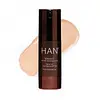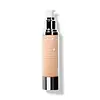What's inside
What's inside
 Key Ingredients
Key Ingredients

 Benefits
Benefits

 Concerns
Concerns

No concerns
 Ingredients Side-by-side
Ingredients Side-by-side

Titanium Dioxide 6%
Cosmetic ColorantCoconut Alkanes
EmollientCocos Nucifera Oil
MaskingCaprylic/Capric Triglyceride
MaskingAloe Barbadensis Leaf Juice
Skin ConditioningRicinus Communis Seed Oil
MaskingEthyl Macadamiate
Skin ConditioningShea Butter Ethyl Esters
EmollientGlycerin
HumectantBeeswax Polyglyceryl-3 Esters
Emulsion StabilisingPolyhydroxystearic Acid
EmulsifyingDisteardimonium Hectorite
StabilisingSilica
AbrasiveCitrus Aurantium Dulcis Peel Wax
Skin ConditioningKaolin
AbrasiveJojoba Esters
EmollientCoco-Caprylate/Caprate
EmollientCopernicia Cerifera Wax
Persea Gratissima Fruit Butter
EmollientTocopherol
AntioxidantCapric Acid
CleansingOriganum Vulgare Leaf Extract
Skin ConditioningLavandula Angustifolia Oil
MaskingSimmondsia Chinensis Seed Oil
EmollientOlea Europaea Fruit Oil
MaskingArgania Spinosa Kernel Oil
EmollientRosa Canina Seed Oil
EmollientMalic Acid
BufferingTitanium Dioxide 6%, Coconut Alkanes, Cocos Nucifera Oil, Caprylic/Capric Triglyceride, Aloe Barbadensis Leaf Juice, Ricinus Communis Seed Oil, Ethyl Macadamiate, Shea Butter Ethyl Esters, Glycerin, Beeswax Polyglyceryl-3 Esters, Polyhydroxystearic Acid, Disteardimonium Hectorite, Silica, Citrus Aurantium Dulcis Peel Wax, Kaolin, Jojoba Esters, Coco-Caprylate/Caprate, Copernicia Cerifera Wax, Persea Gratissima Fruit Butter, Tocopherol, Capric Acid, Origanum Vulgare Leaf Extract, Lavandula Angustifolia Oil, Simmondsia Chinensis Seed Oil, Olea Europaea Fruit Oil, Argania Spinosa Kernel Oil, Rosa Canina Seed Oil, Malic Acid
Aloe Barbadensis Leaf Juice
Skin ConditioningCucumis Sativus Juice
EmollientEuterpe Oleracea Fruit Oil
Skin ConditioningPunica Granatum Seed Oil
EmollientOryza Sativa Starch
AbsorbentTitanium Dioxide
Cosmetic ColorantZinc Oxide
Cosmetic ColorantPrunus Persica Fruit Extract
AbrasiveCamellia Sinensis Leaf Extract
AntimicrobialPrunus Armeniaca Fruit Extract
Skin ConditioningDaucus Carota Sativa Root Extract
Skin ConditioningPunica Granatum Extract
AstringentTheobroma Cacao Extract
Skin ConditioningLycium Chinense Fruit Extract
AntioxidantSolanum Lycopersicum Fruit/Leaf/Stem Extract
AstringentTocopherol
AntioxidantSodium Ascorbate
AntioxidantEuphorbia Cerifera Cera
AstringentRosmarinus Officinalis Leaf Extract
AntimicrobialOriganum Vulgare Leaf Extract
Skin ConditioningThymus Vulgaris Flower/Leaf Extract
MaskingLonicera Caprifolium Flower Extract
PerfumingLonicera Japonica Flower Extract
Skin ConditioningHydrastis Canadensis Extract
MaskingCinnamomum Cassia Bark
Skin ConditioningAloe Barbadensis Leaf Juice, Cucumis Sativus Juice, Euterpe Oleracea Fruit Oil, Punica Granatum Seed Oil, Oryza Sativa Starch, Titanium Dioxide, Zinc Oxide, Prunus Persica Fruit Extract, Camellia Sinensis Leaf Extract, Prunus Armeniaca Fruit Extract, Daucus Carota Sativa Root Extract, Punica Granatum Extract, Theobroma Cacao Extract, Lycium Chinense Fruit Extract, Solanum Lycopersicum Fruit/Leaf/Stem Extract, Tocopherol, Sodium Ascorbate, Euphorbia Cerifera Cera, Rosmarinus Officinalis Leaf Extract, Origanum Vulgare Leaf Extract, Thymus Vulgaris Flower/Leaf Extract, Lonicera Caprifolium Flower Extract, Lonicera Japonica Flower Extract, Hydrastis Canadensis Extract, Cinnamomum Cassia Bark
 Reviews
Reviews

Ingredients Explained
These ingredients are found in both products.
Ingredients higher up in an ingredient list are typically present in a larger amount.
Aloe Barbadensis Leaf Juice comes from leaves of the aloe plant. Aloe Barbadensis Leaf Juice is best known for helping to soothe sunburns. It is also anti-inflammatory, moisturizing, antiseptic, and can help heal wounds.
Aloe is packed with good stuff including Vitamins A, C, and E. These vitamins are antioxidants, which help fight free-radicals and the damage they may cause. Free-radicals are molecules that may damage your skin cells, such as pollution.
Aloe Barbadensis Leaf Juice also contains sugars. These sugars come in the form of monosaccharides and polysaccharides, folic acid, and choline. These sugars are able to help bind moisture to skin.
It also contains minerals such as calcium, 12 anthraquinones, fatty acids, amino acids, and Vitamin B12.
Learn more about Aloe Barbadensis Leaf JuiceOregano leaf is a culinary and medicinal herb with skin conditioning properties.
Titanium dioxide is a mineral UV filter widely used in sunscreens and cosmetics.
It is one of only two UV filters officially classified as “mineral” by regulatory agencies, the other being zinc oxide.
Titanium dioxide provides broad-spectrum protection mostly in the UVB and UVAII range, with some protection in the UVAI range.
While its UVA protection isn’t as strong as zinc oxide’s, the difference is minor.
A common myth is that mineral UV filters reflect UV light. However, modern research shows titanium dioxide absorbs UV radiation like chemical filters (~95% absorption & 5% reflection).
Thanks to its non-irritating nature, titanium dioxide is suitable for sensitive, acne-prone, or redness-prone skin. It is unlikely to cause "eye sting" like other sunscreen ingredients.
A major drawback of this ingredient is its white cast and thick texture. This is why mineral sunscreens often leave a white cast and are less cosmetically elegant than chemical/hybrid sunscreens.
To improve white cast and spreadability, micronized or nano-sized titanium dioxide is often used.
There are ongoing concerns surrounding nano-titanium oxide's impact on marine ecosystems.
There is no conclusive evidence that any form of titanium oxide (or any other sunscreen ingredients) will cause harm to marine ecosystems or coral reefs. The science is still developing but many consumers are keeping a close eye on this issue.
Please note, many destinations have reef-safety sunscreen rules. For instance, the U.S. Virgin Islands advises all visitors to use non-nano mineral sunscreens.
Nano mineral sunscreens once raised safety concerns about absorption into skin.
Extensive research has shown that they do not penetrate healthy or damaged skin; they remain safely on the surface and the top layer of dead skin (stratum corneum).
You'll likely find titanium dioxide bundled with alumina, silica, or dimethicone. These ingredients help make titanium dioxide highly photostable; this prevents it from interacting with other formula components under UV light.
Learn more about Titanium DioxideTocopherol (also known as Vitamin E) is a common antioxidant used to help protect the skin from free-radicals and strengthen the skin barrier. It's also fat soluble - this means our skin is great at absorbing it.
Vitamin E also helps keep your natural skin lipids healthy. Your lipid skin barrier naturally consists of lipids, ceramides, and fatty acids. Vitamin E offers extra protection for your skin’s lipid barrier, keeping your skin healthy and nourished.
Another benefit is a bit of UV protection. Vitamin E helps reduce the damage caused by UVB rays. (It should not replace your sunscreen). Combining it with Vitamin C can decrease sunburned cells and hyperpigmentation after UV exposure.
You might have noticed Vitamin E + C often paired together. This is because it is great at stabilizing Vitamin C. Using the two together helps increase the effectiveness of both ingredients.
There are often claims that Vitamin E can reduce/prevent scarring, but these claims haven't been confirmed by scientific research.
Learn more about Tocopherol